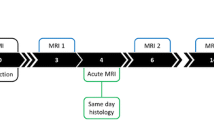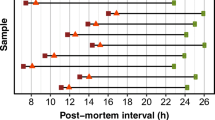Abstract
Objectives
We sought to evaluate the effectiveness of post-mortem cardiac magnetic resonance (PM-CMR) for the identification of myocardial ischemia as cause of sudden cardiac death (SCD) when the time interval between the onset of ischemia and SCD is ≤ 90 min.
Methods
PM-CMR was performed in 8 hearts explanted from pigs with spontaneous death caused by occlusion of the left anterior descending coronary artery: 4 with SCD after ≤ 40 min of coronary occlusion and 4 between 40 and 90 min. PM-CMR included conventional T1 and T2-weighted image and T1, T2, and T2* mapping techniques. Imaging data were compared and validated with immunohistochemical evaluation of the altered proportion and redistribution of phosphorylated versus non-phosphorylated connexin 43 (CX43 and npCX43, respectively), an established molecular marker of myocardial ischemia.
Results
At T2-weighted images, the ischemic core was hypointense (core/remote ratio 0.67 ± 0.11) and surrounded by and hyperintense border zone. Compared to remote myocardium, the ischemic core had higher T1 (p = 0.0008), and lower T2 (p = 0.007) and T2* (p = 0.002). Cytoplasmatic npX43 and the npCX43/CX43 ratio were significantly higher in animals deceased > 40 min than in others.
Conclusion
PM-CMR can reliably detect early signs of myocardial damage induced by ischemia, based on conventional pulse sequences complemented by a novel ad hoc application of quantitative mapping techniques.
Key Points
• Post-mortem MRI may help to understand cause of sudden cardiac death.
• Post-mortem MRI allows detection of signs of myocardial ischemia as cause of sudden cardiac death within 90 and 40 min following coronary occlusion as demonstrated in a pig model of myocardial ischemia.
• Signs of myocardial ischemia using conventional and mapping MRI technique are associated with the immunohistochemical changes of phosphorylated and dephosphorylated connexin-43 which is an established molecular marker of myocardial ischemia.





Similar content being viewed by others
Abbreviations
- AMI:
-
Acute myocardial infarction
- CP:
-
Cytoplasm
- CX43:
-
Phosphorylated connexin-43
- FSE:
-
Fast spin echo
- ID:
-
Intercalated disk
- LCB:
-
Lateral cellular border
- LV:
-
Left ventricle
- MOLLI:
-
Modified Lock-Locker
- npCX43:
-
Dephosphorylated connexin-43
- PM-MRI:
-
Post-mortem cardiac magnetic resonance
- SCD:
-
Sudden cardiac death
- SSFP:
-
Steady-state free precession
References
Myerburg RJ, Castellanos A (1997) Cardiac arrest and sudden death. In: Braunwald E (ed) Heart disease: a textbook of cardiovascular medicine. WB Saunders, pp 742–779
Benjamin EJ, Blaha MJ, Chiuve SE et al (2017) Heart disease and stroke statistics–2017 update: a report from the American Heart Association. Circulation 135:e146–e603
Brinkmann B, Sepulchre M, Fechner G (1993) The application of selected histochemical and immunohistochemical markers and procedures to the diagnosis of early myocardial damage. Int J Leg Med 106:135–141
Ortmann C, Pfeiffer H, Brinkmann B (2000) A comparative study on the immunohistochemical detection of early myocardial damage. Int J Leg Med 113:215–220
Turillazzi E, Di Paolo M, Neri M, Riezzo I, Fineschi V (2014) A theoretical timeline for myocardial infarction: immunohistochemical evaluation and western blot quantification for interleukin-15 and monocyte chemotactic protein-1 as very early markers. J Transl Med 12:188
Kawamoto O, Tomomi M, Ishikawa T, Hitoshi M (2014) Immunohistochemistry of connexin 43 and zonula occludens-1 in the myocardium as markers of early ischemia in autopsy material. Histol Histopathol 29:767–775
Hesketh GG, Shah MH, Halperin VL et al (2010) Ultrastructure and regulation of lateralized connexin43 in the failing heart. Circ Res 106:1153–1163
Beardslee MA, Lerner DL, Tadros PN et al (2000) Dephosphorylation and intracellular redistribution of ventricular connexin43 during electrical uncoupling induced by ischemia. Circ Res 87:656–662
Guidi B, Aquaro GD, Gesi M, Emdin M, Di Paolo M (2018) Postmortem cardiac magnetic resonance in sudden cardiac death. Heart Fail Rev 23:651–665
Di Bella G, Siciliano V, Aquaro GD et al (2013) Scar extent, left ventricular end-diastolic volume, and wall motion abnormalities identify high-risk patients with previous myocardial infarction: a multiparametric approach for prognostic stratification. Eur Heart J 34:104–111
Ruder TD, Ebert LC, Khattab AA, Rieben R, Thali MJ, Kamat P (2013) Edema is a sign of early acute myocardial infarction on post-mortem magnetic resonance imaging. Forensic Sci Med Pathol 9:501–505
Gabisonia K, Prosdocimo G, Aquaro GD (2019) MicroRNA therapy stimulates uncontrolled cardiac repair after myocardial infarction in pigs. Nature 569:418–422
Lionetti V, Aquaro GD, Simioniuc A (2009) Severe mechanical dyssynchrony causes regional hibernation-like changes in pigs with nonischemic heart failure. J Card Fail 15:920–928
Aquaro GD, Camastra G, Monti L et al (2017) Working Group “Applicazioni della Risonanza Magnetica” of the Italian Society of Cardiology. Reference values of cardiac volumes, dimensions, and new functional parameters by MR: a multicenter, multivendor study. J Magn Reson Imaging 45:1055–1067
Webb B, Manninger M, Leoni M et al (2020) T2 and T2∗ Mapping in ex situ porcine myocardium: myocardial intravariability, temporal stability and the effects of complete coronary occlusion. Int J Leg Med 134:679–690
Jackowski C, Warntjes MJ, Berge J, Bar W, Persson A (2011) Magnetic resonance imaging goes postmortem: noninvasive detection and assessment of myocardial infarction by postmortem MRI. Eur Radiol 21:70–78
Haaf P, Garg P, Messroghli DR, Broadbent DA, Greenwood JP, Plein S (2016) Cardiac T1 mapping and extracellular volume (ECV) in clinical practice: a comprehensive review. J Cardiovasc Magn Reson 18:89
Messroghli DR, Moon JC, Ferreira VM et al (2017) Clinical recommendations for cardiovascular magnetic resonance mapping of T1, T2, T2* and extracellular volume: a consensus statement by the Society for Cardiovascular Magnetic Resonance (SCMR) endorsed by the European Association for Cardiovascular Imaging (EACVI). J Cardiovasc Magn Reson 19:75
Ahn JW, Huh GY (2015) The efficacy of connexin 43 expression in the myocardium as an early ischemic marker in forensic autopsy. Korean J Leg Med 39:6–11
Guensch DP, Yu J, Nadeshalingam G, Fischer K, Shearer J, Friedrich MG (2016) Evidence for acute myocardial and skeletal muscle injury after serial transthoracic shocks in healthy swine. PLoS One 11:e0162245
Funding
This study has received funding by the Italian Ministry of Health grant RF-2011-02348164 “CardioRigen” (FAR).
Author information
Authors and Affiliations
Corresponding author
Ethics declarations
Guarantor
The scientific guarantor of this publication is Giovanni Donato Aquaro.
Conflict of interest
The authors of this manuscript declare no relationships with any companies whose products or services may be related to the subject matter of the article.
Statistics and biometry
Giovanni Donato Aquaro kindly provided statistical advice for this manuscript.
Informed consent
Approval from the institutional animal care committee was obtained.
Ethical approval
Institutional Review Board approval was obtained.
Methodology
• prospective
• experimental
• performed at one institution
Additional information
Publisher’s note
Springer Nature remains neutral with regard to jurisdictional claims in published maps and institutional affiliations.
Supplementary Information
ESM 1
(DOCX 17 kb)
Rights and permissions
About this article
Cite this article
Aquaro, G.D., Di Paolo, M., Guidi, B. et al. Post-mortem CMR in a model of sudden death due to myocardial ischemia: validation with connexin-43. Eur Radiol 31, 8098–8107 (2021). https://doi.org/10.1007/s00330-021-07890-1
Received:
Revised:
Accepted:
Published:
Issue Date:
DOI: https://doi.org/10.1007/s00330-021-07890-1




